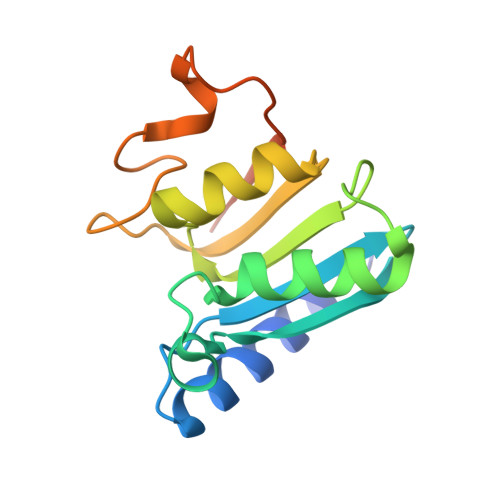Biochemical and Structural Studies of A-to-I Editing by tRNA:A34 Deaminases at the Wobble Position of Transfer RNA
Elias, Y., Huang, R.H.(2005) Biochemistry 44: 12057-12065
- PubMed: 16142903
- DOI: https://doi.org/10.1021/bi050499f
- Primary Citation of Related Structures:
2A8N - PubMed Abstract:
Initial RNA transcription produces several tRNAs (one in prokaryotes and plant chloroplasts and seven or eight in eukaryotes) that contain an adenosine (A) at the wobble position (position 34). However, in all cases, adenosine at position 34 is post-transcriptionally converted to inosine (I), producing mature tRNAs without adenosine at the wobble position. The enzymes responsible for this A-to-I conversion in tRNA are tadA (acting as a homodimer) in prokaryotes and the heterodimeric ADAT2-ADAT3 complex in eukaryotes. The genes encoding these proteins are essential for cell viability, illustrating the biological importance of A-to-I editing at the wobble position of tRNA. In this study, recombinant tadA proteins from Escherichia coli, Agrobacterium tumefaciens, and Aquifex aeolicus, as well as the ADAT2-ADAT3 proteins from Saccharomyces cerevisiae, were overexpressed in E. coli and purified to homogeneity by chromatography. Crystallization of a proteolytically cleaved A. tumefaciens tadA (missing the last eight amino acids at the C-terminus) produced high-quality crystals, and the structure was determined at 1.6 A resolution. In addition, enzymatic assays of the wild-type proteins as well as several mutants were carried out using both the full-length E. coli tRNA(arg2) and the truncated anticodon stem-loop motif as substrates. Our biochemical and structural studies, in combination with sequence and structural comparisons with other deaminases, allow us to propose a model of tadA-tRNA interaction that explains the molecular basis of tRNA recognition by tadA. In particular, a conserved FFxxxR motif at the C-terminus, which is unique to tadA, has been identified, and its critical role in tRNA substrate recognition is proposed. Furthermore, the structural study of prokaryotic tadA presented here also sheds light on tRNA substrate recognition and the possible evolutionary origin of the eukaryotic ADAT2-ADAT3 heterodimer.
Organizational Affiliation:
Department of Biochemistry, School of Molecular and Cellular Biology, University of Illinois, 600 South Mathews Avenue, Urbana, Illinois 61801, USA.















